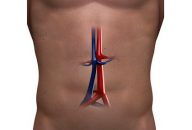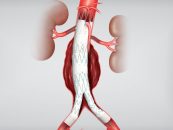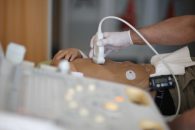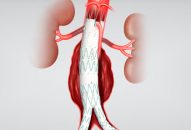Today endovascular aneurysm repair (EVAR) is the preferred option to treat patients with abdominal aortic aneurysms, even though studies have shown reintervention rate is around 20% at 5 years. Consequently, guidelines recommend life EVAR surveillance imaging to identify and treat eventual leaks and prevent aneurysms from growing and eventually rupturing. There are several population and observational studies…
Endovascular Strategy Seems Superior against Surgery in Ruptured Aneurysms
Compared to surgery, endovascular repair of ruptured abdominal aorta aneurysms has better clinical results, survival and quality of life for patients (in addition to being cost-effective), according to mid-term outcomes of the IMPROVE study, recently published in the British Medical Journal. Even though the initial outcomes had not shown differences between both strategies in terms of…
How Is Renal Function Affected by Endoprosthesis Implantation?
The occurrence of renal failure after any endovascular intervention is associated with increased morbility and mortality. After a coronary intervention (whether it be angioplasty or surgery), renal failure increases mortality 20-fold. Relatedly, surgical repair of an abdominal aortic aneurysm with renal failure is also associated with a significant increase in the number of events. Read…
Minimum Appropriate Follow-Up Reduces Mortality After Endoprosthesis Implantation
No study has been able to prove long-term benefit of regular imaging follow-up after abdominal aortic aneurysm repair by means of endoprosthesis implantation. This is important because the costs for these studies are high, which should be added to potential radiation and contrast morbidity. This work sought to characterize the association between post-endovascular abdominal aortic aneurysm…
SOLACI CACI 2017 | Tipo II Endoleaks: Tratamiento obligatorio o un miedo infundado
Read articles on the main presentations of the second day of SOLACI-CACI 2017 Congress. See the presentation by Dr. Hugo Londero, entitled “Tipo II Endoleaks: Tratamiento obligatorio o un miedo infundado”. We are interested in your opinion. Please, leave your comments, thoughts, questions, etc., below. They will be most welcome.
Risk of spinal cord infarction in aortic aneurysm repair
Spinal Cord infarction represents roughly 1% of all strokes and can lead to severe impairment, like paraplegia or quadriplegia. Aortic endovascular and surgical repair of aortic aneurysms or dissections could result in spinal cord infarction, because the vascular supply of the spinal cord largely originates directly from the aorta. Spinal cord ischemia (SCI) rate in patients undergoing aortic repair varies depending on the…
AAA Screening in Men Over 65 Reduces Mortality
Systematic screening for abdominal aortic aneurysm (AAA) targeting all men over 65 years old (not just those presenting risk factors) was associated with a drop in the mortality rate specific for this disease, according to the Swedish Nationwide Screening Program. While 667 men were examined for AAA, the number of patients who required treatment to prevent…
TAAA: Better Outcomes with Renal Fenestration
Courtesy of Dr. Carlos Fava. Thoraco-abdominal aneurysms (TAAA) are a real challenge for surgeons. So far, endovascular repair have rendered good results in these aneurysms, but branch occlusion continues to be their Achilles’ heel”. 449 patients were analyzed, 235 (52%) were treated with branched devices (BEVAR) and 214 (48%) with fenestrated devices (FEVAR).…
Endoleaks Type II: no association with mortality
Original Title: Risk factors and consequences of persistent type II endoleaks. Reference: Ruby C. Lo et al. J Vasc Surg 2016;63:895-901 The presence of type II endoleaks is infrequent (1%-10%) and most cases resolve spontaneously at 12 months. When they don’t, there is still controversy as to whether they may be associated to aneurysm diameter…
Do We Need a New Classification System for Aortic Dissection?
Original Title: DISSECT: A New Approach to Categorization of Aortic Dissection. Reference: M.D. Dabe, et al. Eur J Vasc Endovasac Surg 2013;46:175-90 Courtesy of Dr. Carlos Fava Interventional Cardiologist Favaloro Foundation – Argentina Aortic dissection is a lethal disease, especially in its first stages. The current classification systems (DeBakey 1965 and Stanford 1970) are widely used…
Persistent intraoperative leak Type 1A after stent implantation
Original title: Outcomes of persistent intraoperativa Type Ia endoleak after Standard endovascular aneurysm repair. Reference: Alistair Millen, et al. J. Vasc. Surg 2015;61:1185-91 The purpose of Endovascular Aneurysm Repair (EVAR) in the infrarenal abdominal aortic aneurysms (IAAA) is to prevent growth and rupture. Inadequate proximal seal by the stent favors the presence of leak type 1A that preserves…









